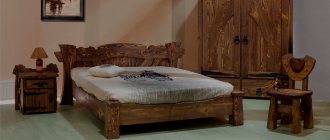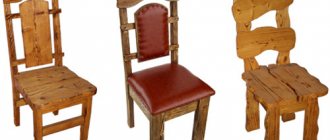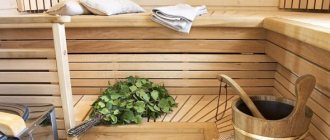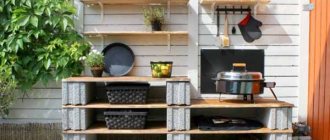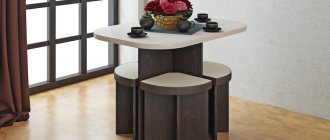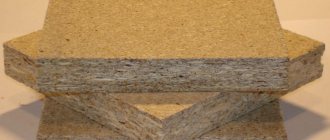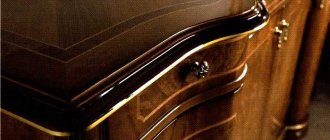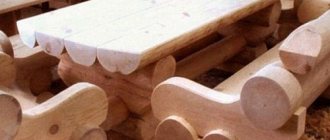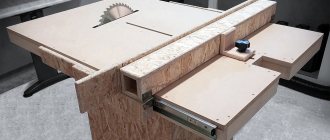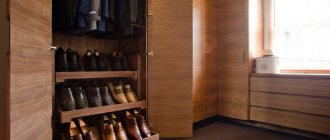A table is not just a piece of furniture. In every house or apartment, it is also a place that gathers all family members around it. Therefore, if the table is not just a structure, but a witness of the past, imbued with the spirit of the times, it creates a special atmosphere in the house. But purchasing solid antique furniture is an expensive endeavor that few can afford. If you need to get an inexpensive antique table, a DIY table is the best way to solve the problem.
If we are talking about creating a piece of antique furniture yourself, then it will most likely be made of wood or wood materials, sometimes with the use of metal parts.
How to prepare furniture for decoration
- It is advisable to free the piece of furniture from its fittings (for example, handles).
- Remove decorative or protective coating. Emery cloth will help to remove a layer of old paint, and at the same time remove dirt. It is better to wipe greasy, greasy surfaces with a cloth soaked in a solution of laundry soap. Then dry. Remove the varnish coating using special products produced by the chemical industry.
Attention! When aging furniture, there is no need to fill small flaws and cracks with putty. They will become part of the decor. Therefore, in the future they should be highlighted and emphasized.
Antique painting of products
The aging effect manifests itself when dark areas peek through light paint, and vice versa.
A popular method of aging wood is painting furniture products. Benches, cabinets and tables are usually painted. All kinds of chests of drawers and bookshelves look original. Preliminary preparation of the tree occurs as in the previously described techniques. You can speed up the processing process using a drill and a grinding wheel. When choosing paint, choose a washed out, fuzzy color. Professional carpenters recommend using paint that is used for interior wall and ceiling painting.
Painting aged wood in several layers
Read also: Homemade mousse recipes
Before painting the product
- Remove the fittings.
- Remove the top layer of coating with sandpaper.
- Clean the working area from dirt and dust particles with a soap solution.
- The treated surface is dried.
- Carefully lower the roller into the paint and paint the product.
Surface painting begins with difficult-to-work furniture parts
It is recommended to start painting in an inconspicuous area to understand the entire process. You need to paint, forming wide and even strokes to prevent drips. Paint the corners carefully. The second layer of paintwork is applied only after the first layer has completely dried. Objects begin to age after varnishing. Aging occurs in this way:
Paint bleed effect
After two coats of paint have been applied, lightly apply paint of a different color. This should be done using a dry brush, touching it only in certain places. For a greater contrast effect, it is recommended to use colors that differ in shades. For example, if the main color of the chairs is blue, then olive-colored paint may also show through on the surface. This technique is called “dry brush”, and such work can be done as follows. A dry brush should be dipped a little into the paint, and then wiped with a dry rag. The tool is now ready to apply an almost transparent layer of paint to the pre-painted base. This technique can also be used in cases where it is necessary to obtain the effect of old paint that has become ingrained into the wood.
How to age a table?
To make an antique table with your own hands, you need to prepare drawings of the intended design, tools, materials and begin the creative process.
Required material
To create high-quality antique furniture, the following is used:
- natural wood from which furniture will be created;
- paints and varnishes (stain, varnish);
- high-quality fittings (locks, mechanisms, handles) that match the style of the intended product;
- decorative items.
Having prepared the necessary material and drawings of the desired product, processing of wood products begins.
Required Tools
Read also: Do-it-yourself Otg cable usb type c
When making an antique wooden table with your own hands, you will need:
- different caliber sandpaper;
- metal brush;
- hacksaw, saw;
- grinding machine with different attachments.
Tools for working with wood using the artificial aging technique
Toning with waxes
You can also give furniture and accessories an aged look using waxes. A particularly visible effect will be obtained if the surface has protrusions and indentations or if the surface itself is quite textured. Select wax depending on the desired effect: if you want to see a more pronounced result, take one that is more contrasting.
Laichah: You can combine several different types of wax when tinting to get a more interesting result.
Read also: DIY button tree panel
- Decoration
For retro lovers: how to decorate an interior in the style of the sixties
Methods for aging a wooden surface
There are several special decorative techniques that allow you to visually age the material by changing its structure:
- Thermal. When using the thermal method, you must be able to use an open fire source. An open fire is directed onto a wooden surface, causing layers of material to burn unevenly (depending on softness/hardness), which creates the desired effect. Then the burnt wood is processed with sandpaper and coated with a protective varnish.
- Chemical. The simplest of the listed methods is the use of special chemical reagents. But it is not popular, since working with harmful substances can have a detrimental effect on health.
- The mechanical method includes several options. One of the most popular is to process the wood along the grain with a wire brush. In this way, the soft layers of wood are removed, creating an unusual relief structure. After this, the wood is sanded with sandpaper and then varnished.
You can also age the surface thanks to the abraded effect. Cover the product with 2-3 layers of the selected paint, after rubbing the areas most susceptible to abrasion with wax or paraffin. After the paint or varnish has dried, rub the treated areas with sandpaper.
If you want to put any of the methods into practice, we recommend that you first try it on a small piece of the material from which the table is made. If you like the result, move on to processing the main product.
Shabby and faded furniture
Two-layer painting is used here. Preferable shades are “coffee with milk”, “ivory” or “baked milk”, which are obtained by adding color to white paint.
- Apply the first layer - the base color, and wait for it to dry.
- The second layer is the prepared shade, which requires a clean brush to apply. You should also wait until it dries completely.
- Using coarse sandpaper, sand the surfaces to create the desired abrasion.
- To fix it, apply varnish.
Advice. Difficult and invisible areas are painted first.
Patination technique for wooden furniture
Patination is the process of imparting an exquisite antiquity to furniture, metal or plaster parts in various ways. To create a patina on furniture, it is necessary to unevenly apply dark acrylic paint, bitumen varnish or dark wax to the surface.
Follow these step-by-step instructions to patina your furniture yourself:
- First, apply a layer of acrylic paint of the selected base color to the primed surface. Let the surface dry. Then, using a dry brush technique, apply some umber in horizontal stripes.
- Take a small amount of bitumen varnish and, using a bristle flange brush, apply horizontal stripes with light pressure. Let dry. The drying time for bitumen varnish is recommended by the manufacturer.
- Using a bristle brush and some white acrylic paint, draw vertical lines across the entire surface of the piece. Let the surface dry.
Follow this step-by-step tutorial on how to patina furniture surfaces to create “old paint marks.” As a result, the surface looks aged.
There are several patination techniques. It all depends on what brush you choose to work with.
One of the simple techniques for patinaing furniture is to pull the brush in different directions. For this technique, good results can be achieved by using a synthetic or bristle paint brush.
By drawing the brush you can get uniform horizontal or vertical lines. Have no doubt, these lines will look very impressive on absolutely any wooden furniture, and you will be satisfied with the result.
After taking a new portion of paint, be sure to blot the brush on the paper, removing the excess. It should be almost dry.
Using the drawing technique, you can imitate brushing, in this case taking a little light paint on a dry brush.
Another way to age furniture
There are other aging techniques. For example, they combine fermentation with painting in the style of scuffs. To do this, freshly peeled wood is painted with faded paint. As a result, the ridges are painted over, but the furrows continue to have a natural dark tint.
Important! To decorate furniture “antique”, you can apply gold spider web to it. This can be done using a sponge, which must be dipped in golden paint. But in any case, the last step is always varnish, which gives the product completeness.
Preparatory work
Before you paint old furniture with your own hands, you need to do the following preparatory work:
- We clean all the parts. If remnants of the previous coating are found on the tree, they must be removed. We dismantle small parts;
- Grinding. The paint will not lie flat on the surface unless it is first sanded, removing any bumps or swellings that have appeared over time. You can watch how to remove the remnants of past decor in the available videos on the Internet;
- We remove dirt and dust accumulations;
- Apply an antiseptic primer. It is necessary so that during operation the tree does not begin to rot;
- If the furniture is in good condition and no chipped parts are found, then putty is not needed. Otherwise, you need to fill the chips with a special mixture for wood;
- Dry the cleaned and primed parts for several hours.
Cleaning the surface
Sanding the coating
Removing dust and dirt
Apply primer
Applying patina yourself
It is advisable to carry out patination work in the fresh air, using protective equipment. First, the necessary furniture or ordinary wood is prepared, and only then the coloring compounds are applied.
Preparation
If you have to work with solid wood furniture, first clean it with sandpaper or a wire brush to remove old varnish and paint. After this, if there is severe damage, they should be repaired with wood putty, dried and sanded again. Then the primer is applied to the wood and left to dry for about 10 hours - the exact time is indicated on the primer package.
The process of preparing laminated furniture for patination is slightly different. First, the surface is also brushed with sandpaper. Then an adhesive insulator is applied, and after it dries, a colorless polyurethane primer is applied.
Patination with stain
Patination with stain is one of the easiest ways to “age” furniture. To do this, a wire brush is passed over the surface of the furniture to remove soft fibers and highlight the texture of the wood.
Afterwards the painting process itself occurs - it can be carried out in different ways:
- sponge;
- brush;
- roller;
- spray.
There are several secrets for working with stain for more uniform coloring:
- simple - you need to wet the furniture with warm water, wipe with a dry cloth to remove excess. Then you can apply the composition;
- difficult - saturate the wood with a special conditioner. It is applied every 20 minutes until it stops being absorbed. After this point, you need to wait half an hour and only then apply paint.
The stain must be applied in two layers. Next, you can apply a metallic patina to the raised relief surfaces. The resulting result is secured with wax or shellac.
Classic way
This method is suitable not only for solid wood, but also for MDF or LSDP furniture.
In short, the sequence of actions is as follows:
- Apply the first layer of acrylic paint. There are no specific requirements for how to apply it correctly - you can make neat or, conversely, rough strokes. Leave for a day until dry.
- Rub off a thin layer of paint with sandpaper to create an antique effect. Polish with a rag.
- Apply a second layer of acrylic paint. It may be the same as the first one, different or have a metallic sheen. This layer should be thin, so it should be blended well. If desired, you can sand it with sandpaper. Leave for a day until dry.
- Cover with matte acrylic varnish and leave for half a day until dry.
Such simple steps will give your furniture a sophisticated and elegant look.
Craquelure
Craquelure is an unusual patination technique that results in furniture covered with a web of small cracks. There are several ways to create this effect.
Faceted varnish is the simplest of them. This is a special water-based mixture that cracks when dried. The more layers of this composition you apply, the more cracks you will get. Faceted varnish can be either transparent or colored: it can be applied to painted or untreated furniture - working with this type of patina is very convenient, which is reflected in its cost.
There is another way to achieve cracks on the surface of furniture - alternately layering paint and varnish. First, the furniture is painted with acrylic paint and allowed to dry, then craquelure varnish and matte water-based paint are applied. Then follows the finishing coat, which must be very thin so as not to hide the structure of the cracks that have appeared.
There is also a so-called two-phase craquelure patination technology. For this you need to apply shellac varnish in 2-3 layers, drying each one well. Then the surface is covered with craquelure varnish, after it dries, the resulting cracks are rubbed with bitumen wax and the entire furniture is covered with shellac. This technology makes cracks more noticeable, but less noticeable in structure.
After applying the stain, the structure of the wood becomes visible
Advice! To apply stain in the old style, you should make a special swab - wrap a small piece of cotton wool in a cotton cloth.
The stain is poured in small portions onto the cotton wool and applied to the wood with light touches. In such work, the main thing is that the stain does not flow out when you press the swab. The wood should be coated several times.
- Near locks, handles, and on the corners, the coated stain is sanded with sandpaper to achieve natural abrasions;
Working with sandpaper
- Then the entire surface is covered with two layers of colorless varnish.
Applying a layer of clear varnish
All wooden objects painted in this way will have a natural wood pattern, which is typical for old interior elements.
There are other ways to age furniture and any other wooden items. Let's look at one of them using the example of how to paint an antique table.
First comes the preparation. After this, apply a layer of paint of any characteristic color, for example, gray.
Advice! To ensure that the pattern of wood fibers is visible through the paint, only one layer is applied.
Next, they create a shabby effect, as in the previous method, and in the same places. The next step is to achieve the effect of the old paint appearing from under the new.
This is done simply: the brush is slightly dipped in paint of a color different from the first layer. Then it is wiped with a dry cloth, and then smeared with force over the surface.
Article on the topic: Do-it-yourself folding table for the garage
The photo shows that one paint appears from under the other.
It turns out that not the entire surface is painted, which creates the illusion of antiquity.
Applying paint using a dry cloth method
Another way to age furniture is to create the illusion of dirt. For this, dark wax is used to cover the wood. It is worth painting unevenly.
After painting, the wax is covered with dark varnish.
Uneven application of dark wax
How to create an antique wood interior?
The aging effect manifests itself when dark areas peek through light paint, and vice versa
A popular method of aging wood is painting furniture products. Benches, cabinets and tables are usually painted. All kinds of chests of drawers and bookshelves look original. Preliminary preparation of the tree occurs as in the previously described techniques. You can speed up the processing process using a drill and a grinding wheel.
Painting aged wood in several layers
Before painting the product
- Remove the fittings.
- Remove the top layer of coating with sandpaper.
- Clean the working area from dirt and dust particles with a soap solution.
- The treated surface is dried.
- Carefully lower the roller into the paint and paint the product.
Surface painting begins with difficult-to-work furniture parts
It is recommended to start painting in an inconspicuous area to understand the entire process. You need to paint, forming wide and even strokes to prevent drips. Paint the corners carefully. The second layer of paintwork is applied only after the first layer has completely dried. Objects begin to age after varnishing. Aging occurs in this way:
- take fine-caliber sandpaper;
- sandpaper is used to process furniture parts that are susceptible to abrasion (corners, protruding elements).
The erasing process is controlled by a master.
Antique furniture made by yourself has a number of advantages:
- Saving money.
- Creation of a unique antique set.
- Possibility of using different working methods.
- Things contain the positive energy of the master.
- A self-created item that will fit perfectly into the room.
When creating furniture with your own hands, it is worth considering its appearance down to the smallest detail.
Features of finished aged furniture
If you are not a fan of working with your own hands, then the best option would be to purchase furniture in showrooms and other retail outlets, or choose custom-made furniture.
Today, many furniture factories, as well as small private workshops, produce small-scale or even unique antique furniture, taking advantage of all the advantages of industrial technologies. When making antique furnishings, several techniques are used.
Selection of materials
A carefully polished board or beam of the correct geometric dimensions becomes faceless and can be used anywhere. The first and most obvious step to achieve a vintage effect is to use materials that have their own “character”, bear the stamp of time, and also correspond to the style of those times when furniture production did not yet have precision machines and woodworking equipment.
Accordingly, the products turned out to be somewhat clumsy and rough (at least when we are talking about the Middle Ages).
The word “vintage” comes from winemaking - it means the advantage of vintage wines aged for several decades over younger products. In clothing, design, and furniture, this means the revival of stylistic traditions of previous eras.
For example, putting a bureau in the office instead of a comfortable closet or desk, and in the bedroom - a high bed with nickel-plated balls - is clearly vintage.
In order to achieve the effect of aged furniture, parts of wood are taken to make it, in which uneven edges, knots, structural defects are preserved - all these elements imitate handmade work.
.
.
This technique is especially often used in the manufacture of countertops - during assembly, instead of the usual glued solid wood, slabs are taken, which have a unique pattern and shape. We can say that the table is not just aged, but also exclusive.
Expert opinion
Kokovin Dmitry Vasilievich
Furniture restorer
Slab is the name for cutting a tree (usually longitudinal), when the trunk is not cleared of bark and retains its natural shape - bends, knots, splits and other elements that are usually removed during factory production.
Chemical exposure
Furniture production has chemical reagents at its disposal that act on wood in a special way. They damage the top layer of cellulose, but do not act on all surfaces, but form grooves, furrows, spots and other “artifacts”.
The destruction of part of the wood mass imitates time damage, and the unique pattern makes the product unique. Using chemical action, you can even imitate the impact of wood-eating insects, only preserving the strength of the product and making such wear aesthetically pleasing.
Application of forged elements
Aged furniture is not only wood, but also metal parts that were actively used in the 16th – early 20th centuries. An indicator of the advanced age of the furnishings are forged hinges, edging, and corners. Forged dark hinges, handles, and locks are widely used.
Features of brushing
This is one of the most modern and fashionable ways to show how to age natural wood furniture. Medium-density wood is suitable for processing using this method - walnut, coniferous species, oak - it is this that provides a pronounced and very beautiful pattern of the treated surface. The name “brushing” comes from the English word brush: using special metal brushes, the surface is mechanically processed. Most often, the method is used to create interior items in country or Provence style.
The structure of the wood is heterogeneous; dense fibers alternate with looser ones, forming a unique pattern. Under the influence of time, the soft areas are destroyed, giving the tree relief. Today this process can be significantly accelerated, obtaining the desired aging effect in a very short period.
The surface is simply processed in several stages. First, hard metal brushes are used, which rid the wood of soft and loose fibers. The dense texture becomes distinct, and growth rings appear. Then they pass over it with special nylon brushes with abrasive inclusions, which remove roughness. For work, you can use a grinding machine, a drill with special attachments, or a milling cutter.
Wood that ages under natural conditions becomes brittle, loses elasticity, and cracks. Artificial aging of the product allows you to preserve the strength and all the properties of new wood using modern compounds.
The last stage is polishing using sesal brushes or thick felt. After this, the surface is primed and treated with the desired tint compositions, which further emphasize the beauty of the design. It is possible to cover the protruding parts of the surface with a dark stain that contrasts with the light color of the soft fibers. This technique will visually enhance the aging effect. The final varnish coating protects the surface from external influences and adds shine and gloss to it. Brushed boards are great for making antique furniture with your own hands. If necessary, products aged using this method can be returned to their original appearance by simply cleaning the surface.
Advantages of individual furniture design, stages of work
Hard metal brush
Nylon brush with abrasive inclusions
Sesal brush
Artificial aging of the table
If you want to age, for example, a table and get hand-made antique furniture, a diagram or drawing of such a table should be at your fingertips. This is due to the fact that to achieve the best effect, it is recommended to disassemble it into its component parts, which will then be quite difficult to assemble without a drawing or diagram. In addition, based on the new project, you will be able to make changes to the appearance of your future “antique” table.
In order to make such antique furniture with your own hands, you will need to use the following tools and materials:
- sandpaper of different calibers;
- metal brush;
- dark stain;
- furniture varnish.
First, you need to brush the labor-intensive parts of the table; it is better to do this disassembled.
At the first stage, the table is disassembled into parts. As we have already indicated, this is done so that the most inaccessible places on your table can be processed. This treatment will be carried out using sandpaper until paint or varnish is completely removed from the surface of the furniture. The veneer, if it is on the wood, is also removed in order to check how ready the table is for brushing.
Brushed table and chairs look very impressive
After this, you can proceed directly to the work, and if you decide to make antique furniture with your own hands, you will need to keep a photo of the future table with you in order to process it in accordance with the sketch you have chosen. The work itself consists of moving along the wood along the grain with the application of considerable effort. As a result, the wood fibers on the surface of the tree will bristle and separate from the base.
Advice! You can adjust the depth of the furrows you create by going over one place several times.
We cover the brushed wood with a dark stain.
After fermentation is completed, you need to cover the prepared surface with a dark stain. To do this, you will need to wear gloves and a respirator, and immediately remove excess stain from the surface of the wood using a damp sponge. Layers of stain also directly affect the antiquity of any table element.
The final stage of “aging” is coating the furniture with varnish to protect the wood and stain from abrasion and mechanical damage. It can be either transparent or dark (to match the color of the main coating). Moreover, if various materials, such as fabric, are used in the construction of the table, they will also need to be either replaced with original old fabrics or artificially aged.
Advice from the experts
You should choose four colors of paint: two bright ones, gray and basic white.
Use natural conditions for drying. Apply the next layer only after the previous one has dried.
Wax is applied to areas that are frequently touched and touched, creating a frayed appearance.
Putty creates volume, texture and relief, as if the product had been coated with paint many times.
When using the method of artificially aging furniture, 3-5 layers of paint are enough.
MORE: What rope should I use for packing?
After painting, the product is thoroughly sanded, removing excess paint.
Conclusion
Using fashion trends and color combinations, you can turn modern furniture into antique or vintage items. You don’t have to spend money on purchasing an old wardrobe or chest of drawers. Having chosen the appropriate method, you should try to “age” the necessary item yourself, turning it into an antique item.
From the history of the coffee table
This piece of furniture has a very long history, despite the fact that it became most popular in Russia only in the twentieth century. A coffee table is a small table, often elongated or with a round top , which was usually placed in the living room in front of the sofa or between armchairs and served for storing magazines, books and other printed materials. It could also be used to decorate the interior or as a coffee table to place cups of drinks on. According to GOST, this is a small low table intended for decorating premises and using in a recreation area.
Coffee tables
Such tables first appeared in Europe - a part of the world where people love comfort and beauty. The first table was made around the 18th-19th centuries - according to historians, it was made by a certain W. Goodwin. After this, this type of furniture began to be actively produced by a couple of furniture companies.
White coffee table
On a note! The height of the old and modern tables was very different. The ancestors of the modern variation were much taller. The height of the product was particularly influenced by the East, where it is customary to make small tables.
Original coffee table
Nowadays, a coffee table can be seen not only in living rooms, but also in offices and other rooms of the house. Its main difference from a regular table is the small size of the tabletop and relatively low height. Some tables, in addition to the tabletop itself, also have shelves-crossbars, on which it is convenient to place directly the press or any small objects. In some variations of tables, such shelves are replaced with drawers. You can put souvenirs, vases on the tabletop itself, use it as a stand for mugs and glasses during tea drinking, etc. Thanks to such a table, you can create a cozy seating area in the room or create a small corner.
Coffee table in the shape of a six-pointed star
Typically, the height of a coffee table is no more than 50 cm, but in general there are tables that are both smaller and larger. The owner's wishes play a big role here.
Coffee table
